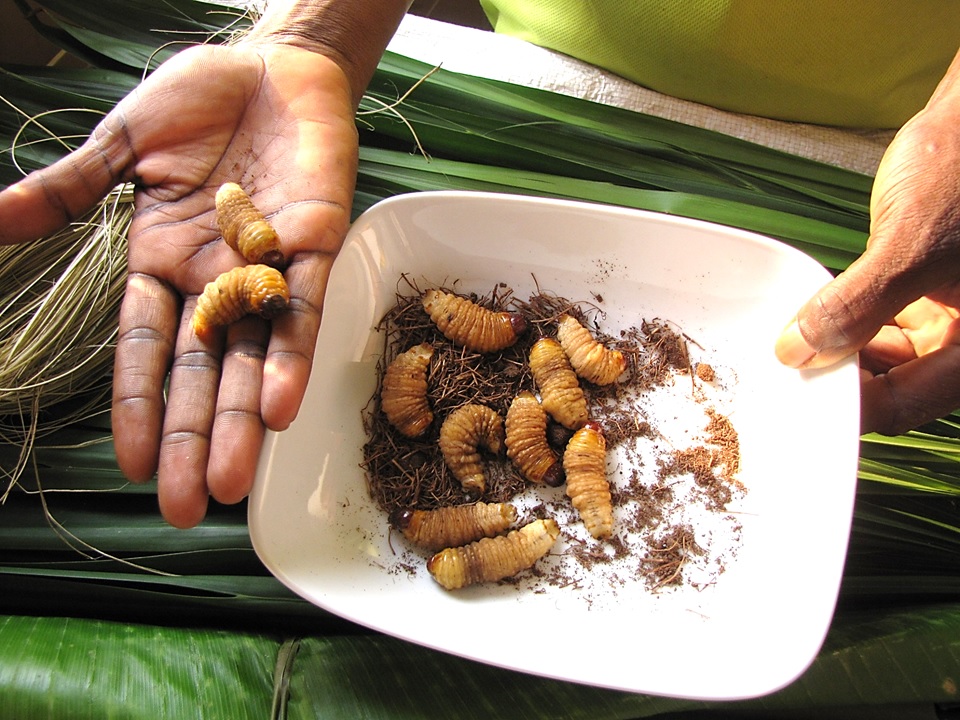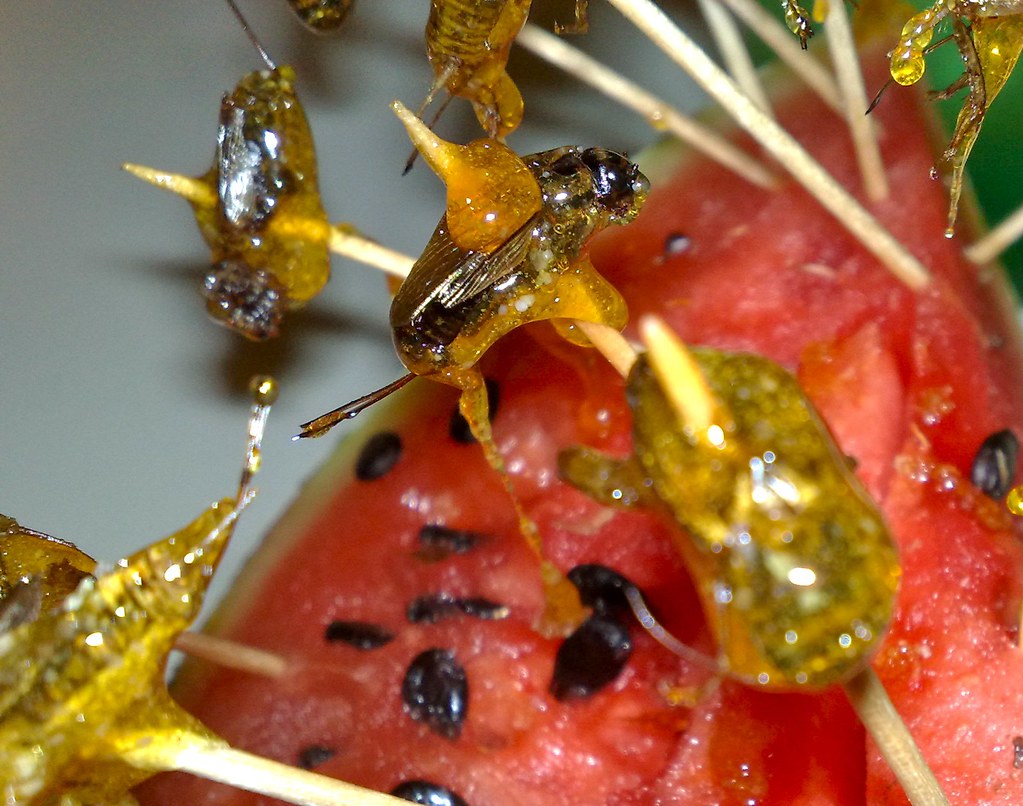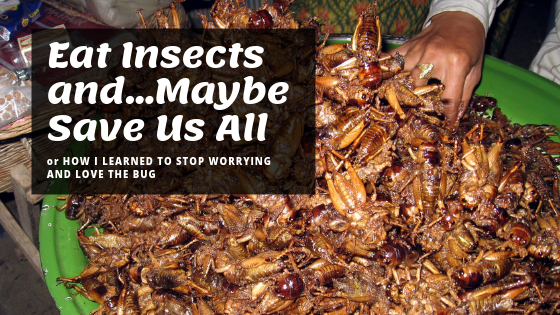Current food strategies in the U.S. are contributing to myriad issues from global warming to obesity. There have been many solutions proposed, and some implemented over the years with little success. In this essay I’d like to explore using insects as food in order to find solutions for many of the problems associated with the production, distribution, consumption, and disposal of food within our current system.
The average American consumes 224 pounds of meat annually. (CME Group, 2011) This meat is usually the products of beef, pork, and chicken. Fish, turkey, veal and lamb make up significantly smaller portions of this total. It can range from 4.7 to 20 pounds of feed to increase a cow’s weight by one pound. (National Research Council, 2000) Hogs require about four pounds of feed to gain one pound of mass (Reese, Liptrap, Parker, Cromwell, & Stahly, 1985), and chickens have a conversion ratio of 2-3 pounds feed to one pound gained. (The Livestock, Environment and Development Initiative, 2006)
The plant products on which these animals feed require huge amounts of land for their production. Methods used to grow them are environmentally harmful, require large amounts of energy, and use many resources in an unsustainable manner.
Efficiency of Insects
Many insects have food conversion ratios of less than two pounds of feed to one pound of weight gained. If we incorporated bugs into our current food systems for protein, we could decrease the amount of land needed to create feed for production animals.
On top of their efficient food conversion, insects can feed on pre-supermarket waste such as bean husks so they wouldn’t compete with existing animal production needs. Some insects can even feed on non-food waste, such as paper. Both these factors would contribute to lessening the total amount of land needed to feed our food animals and reduce greenhouse gas emissions.
Aside from needing less food in order to reach “slaughter age,” insects can be raised using space far more efficiently and less environmentally harmful than modern cattle. The total amount of land degradation, including from water erosion, wind erosion, chemical degradation, and physical degradation associated with raising cattle across the globe is 19.65 million square kilometers, which is about 13% of the total land on earth. (The Livestock, Environment and Development Initiative, 2006) We cannot continue this trend much longer. Insects need only warmth, water and food to grow, so they can be grown nearly everywhere.
Abandoned warehouses and buildings in and around cities could be repurposed to house local production facilities. Insects can be grown in tight spaces in vertical modular cabinet-like structures. A current startup is planning on incorporating both of these ideas into their business model.

The Insect Consumption Process
Ento (short for entomophagy, the practice of eating bugs) is a company in London that is capitalizing on this yet untapped resource in western cultures. They are using modern cuisine techniques to make visually appealing, delicious insect dishes. Many are unrecognizable as insect products, and resemble something more like a sushi platter.
Part of Ento’s plan is to play on the current entomophagy taboo in western cultures by using peer pressure to get people to try their products. Since this concept is new to western cultures, packages would inform the consumer on appropriate serving size, serving suggestions, and nutrition content. They have designs for scalable, modular cabinet systems for production that can be easily transported. These systems could be used efficiently in a variety of existing abandoned structures.
Urban insect farms can be personal or community endeavors as well. Every major city has laws against keeping farm animals within city limits, but few, if any, have restrictions on raising edible insects. Anyone with space under a table or desk can grow bugs. Community insect farming projects could help to bring local communities together and ensure local economic growth. People could exchange different species like tomato growers do with heirloom variety seeds. We would reduce food miles dramatically and help people obtain food security by employing these techniques.
Insects provide high quality protein and supplement the diet significantly with minerals and vitamins that are in short supply in developing nations. Most bugs are a good source of essential fatty acids, some containing more than oily fish. (DeFoliart, 1992) If not used as a direct food source for humans, insects could be fed to animals to increase their levels of Omega-3s and other essential fatty acids. We would then benefit by eating those animals. It is more efficient to eat the insects directly because after having been consumed by the cattle, only about 10% of its total energy will be passed to the next consumer.
Humans have been eating insects for thousands of years. Aristotle recorded how the Greeks enjoyed eating the cicada, and Herodotus and Pliny described such delicacies as the locust and the larvae of the longicorn beetle. (Morris, 2008) There are at least 1386 known edible varieties consumed by humans (Verkerk, Tramper, van Trijp, & Martens, 2007), so this is not a new phenomenon. It is, however, a bit foreign to Americans. Fear Factor was a reality television show dedicated in large part to forcing people to break this taboo, and those that watched contestants chew on caterpillars and crickets squealed painfully in disgust. Ironically, these participants were rewarded for eating what people from some cultures simply call “food.”
Where did this insect aversion come from in Western culture? There is no innate dislike for insects in humans. It’s possible it came from the ‘civilizing process’ stemming from aristocratic court, which began defining etiquette in ways that made insect eating anti-social. (Morris, 2008) Eating insects therefore became ‘uncivilized’ and deemed primitive.
Will Americans ever eat insects? Many Americans eat a bug product every day and don’t even know it. Female Cochineal bugs contain a red chemical that is used as a dye in many food products. Starbucks uses it in their strawberry frappuccinos (Jaslow, 2012), Nestle’ colors their red Smarties with it (Barton, 2007), and many other companies us it in a variety of food products. Both Starbucks and Nestlé are phasing the chemical out of their products, but it is here to stay in many others.
Aside from Ento and more clandestine approaches to entomophagy, it is actually becoming a small trend in gourmet cuisine. The Brooklyn Kitchen has several bug dishes on their menu and hosts sell-out dinners composed of mostly insects. (Lazarowitz, 2010) Dishes are starting to pop up around the country, and distribution is getting a little better.
Potential Risks
Expanding insect farming in the United States could lead to increased incidents of invasive species. With almost 2,000 varieties of edible insects to choose from, we’re bound to run into some that find environments to thrive in. This could cause unpredictable amounts of environmental harm for years or decades. If a mega-farm filled with Aristotle’s cicadas suddenly evacuated its residents, the insects could eat nearly every piece of vegetation for miles. Safety measures would have to be enacted and followed to keep incidents from happening. If the process were gradual enough, regulators would stay ahead.
An infrastructure would need to be in place for the success of American insect farms. Food safety and sanitation protocols would have to be devised and maintained. Growth in this industry is likely to be slow enough for the infrastructure and protocols to grow up around it for some years to come.
Insect protein could be a viable option for our food needs in the near future. They can eat many waste products that traditional cattle cannot and convert that food into body mass at a rate better than cows, pigs, and chickens. The nutritional aspects of insects are better than those of traditional meat animals. Insects can be raised nearly anywhere, including existing abandoned structures for a good use of urban space. The biggest obstacle for large-scale implementation is the taboo associated with eating six-legged creatures in contemporary American society. If trends in population growth and food preferences continue, we may have to get over it out of necessity.

Bibliography
Barton, L. (2007, May 14). Veggies beware! Retrieved November 6, 2012, from The Guardian: http://www.guardian.co.uk/lifeandstyle/2007/may/15/foodanddrink.uk
CME Group. (2011). Daily Livestock Report. Steve Meyer and Len Steiner.
DeFoliart, G. (1992). Insects as human food. Crop Protection, 395-399.
Jaslow, R. (2012, March 27). Starbucks Strawberry Frappuccinos dyed with crushed up cochineal bugs, report says. Retrieved 11 6, 2012, from CBS News: http://www.cbsnews.com/8301-504763_162-57405140-10391704/starbucks-strawberry-frappuccinos-dyed-with-crushed-up-cochineal-bugs-report-says/
Lazarowitz, E. (2010, September 14). Meal at Brooklyn Kitchen might bug you: caterpillars, mealworms and moth larvae are on the menu. Retrieved November 7, 2012, from New York Daily News: http://articles.nydailynews.com/2010-09-14/local/27075258_1_insect-cuisine-eat-bugs-larvae
Morris, B. (2008). Insects as food among hunter gatherers. Anthropology Today, 6-8.
National Research Council. (2000). Nutrient Requirements of Beef Cattle. Washington, D.C.: National Academy Pres.
Reese, D. E., Liptrap, D. O., Parker, G. R., Cromwell, G. L., & Stahly, T. S. (1985). Factors Affecting Feed Conversion in Growing-Finishing Swine. Lexington, KY: Univeristy of Kentucky.
The Livestock, Environment and Development Initiative. (2006). Livestock’s Long Shadow. Rome, Italy: Food and Agriculture Organization of the United Nations.
Verkerk, M., Tramper, J., van Trijp, J. M., & Martens, D. (2007). Insect cells for human food. Science Direct, 25 198-202.

